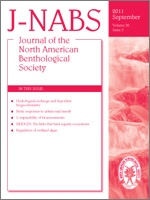Freshwater mussels are one of the most imperiled groups of animals in North America. Effective resource management and conservation efforts require reliable estimates of species diversity and their distributions. However, sampling protocols for qualitative mussel surveys have not been well established and tested. Furthermore, the sampling effort required for a given data-quality goal (90% of species captured) often varies substantially among sites, and application of a standard effort probably would introduce bias into assemblage comparisons. We tested the sampling adequacy of time-based hand searches. We conducted 16-man-hour (mh) searches at each of 18 wadeable stream sites in Illinois that differed widely in environmental factors and historical species diversity and collected 27 to 942 individuals and 5 to 18 species per site. We accounted for imperfect species detectability by using the Chao-1 richness estimator and measured sampling adequacy as the % of the estimated number of species sampled. Four-mh searches, a frequently used effort, captured 15 to 100% of all species with an average of 61%, and yielded estimates of richness that were not significantly correlated with the estimated total richness (Pearson's r = 0.39, p > 0.05). Ten-mh searches captured >70% of all species at >70% of sites and resulted in a significant correlation between observed and estimated richness (Pearson's r ≥ 0.78, p < 0.01). A Random Forests (RF) model based on watershed and habitat characteristics (e.g., stream size and dominant substrate types) accounted for 45% of the variance in sampling adequacy of 4-mh searches. Sampling adequacy decreased with increasing stream size and substrate size but increased with % forest in the riparian zone and logs in the stream. A 2nd RF model was developed to predict the number of man-hours required to capture 70 ± 3% of all species, and it accounted for 37% of the variance. Our findings should serve as a guide for setting standard sampling efforts for mussel surveys in Illinois and probably other midwestern states and should provide a baseline for setting site-specific efforts. Our modeling approach is of general applicability for addressing sampling-adequacy issues in studies of any assemblage.
How to translate text using browser tools
6 September 2011
Assessing sampling adequacy of mussel diversity surveys in wadeable Illinois streams
Jian Huang,
Yong Cao,
Kevin S. Cummings
ACCESS THE FULL ARTICLE
It is not available for individual sale.
This article is only available to subscribers.
It is not available for individual sale.
It is not available for individual sale.
freshwater mussels
Illinois streams
Random Forests
sampling adequacy
species richness
timed sampling





